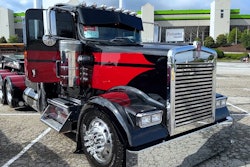The latest oil formulations offer added protection for technology new and old, but analysis is still key to keeping your engine properly lubed.
Can you extend the life of your engine by switching from CH-4 to CI-4, the new category of oil designed for post-October 2002 engines? It’s a difficult question. To make matters more confusing,now there are CI-4 Plus and certain proprietary oil designations to consider, as well. If you’re serious about monitoring the impact of these oils on your engine – whether it’s based on exhaust gas recirculation, Caterpillar’s ACERT or traditional technology – you have got some new things to consider in a regular oil analysis program.
Randy Dunn, an owner-operator leased to Universal Am-Can, hasn’t decided whether to quit using CH-4 for the Detroit Series 60 500-hp plant in the 1997 red Peterbilt 379 he recently bought. He is satisfied with the performance of Wolf’s Head, a Shell subsidiary popular in western Pennsylvania and New York State, which he’s used for years. “But I’ve never had a Detroit before, and I need to find out what they recommend.” The CH-4 should be fine for his pre-EGR, pre-retarded timing machine, but he’s interested in the possibility of extending oil drains.

“I change my own oil right here every 10,000 miles. It costs me $75 every month,” he says. “With this new truck maybe I’d be better off going to the new oil and doing a trend analysis to see if I can save a little money.” Given the age of his engine – 500,000 miles – a little added protection might help save costly repair bills and tows.
Owner-operators, most still using CH-4 in their pre-2002 engines, can benefit from CI-4 and CI-4 Plus oils, says Dan Larkin, a consultant to the oil industry and president of D&L Lubricant Solutions. “CI-4 and Plus do not add as much of a benefit to non-EGR engines, but if you develop a coolant leak or overheat or want to extend drain intervals, CI-4 gives added protection,” he says.
“Because EGR engines run hotter, CI-4 is formulated to handle the added heat stress,” says Alex Bolkhovsky, commercial vehicle lube adviser for ExxonMobil. When oil gets hot, it oxidizes, forming peroxide molecules, which attract contaminants. “CI-4 handles oxidation better than CH-4,” he says. “It keeps the oil from thickening.”
CI-4’s formulation includes higher quality base stocks, inclusion of some old additives and the addition of others. “Oil analysis shows that soot is up in EGR engines,” says Dan Arcy, technical marketing manager for Shell Lubricants. “But alkaline reserves are also dropping at a much faster rate. This means there is less alkaline reserve available to neutralize the higher acid content produced in EGR engines. CI-4 is formulated to counter these trends.”
In EGR engines, exhaust gases drop acids when the gases are recirculated. So the total base number of CI-4 has been increased to neutralize more acid.
“CI-4 also has more detergents,” Bolkhovsky notes. “Detergents help neutralize acids and they help control deposits as well.” EGR engines produce about 50 percent more soot than pre-EGR engines, and more particulates. Both are formed when fuel is burned at lower-than-optimal oxygen levels. The retarded timing of engines built since 1998 adds to less complete combustion of fuel, which also creates soot. While EGR engines did reverse the trend toward more retarded timing somewhat, the engines have more retarded timing than pre-1998 engines. Also, EGR reduces oxygen, making soot the most significant contaminant in the new engines.
The CI-4-Plus formulation came about because Mack and Cummins wanted minor improvements to CI-4, says Chuck Blake, manager of customer fuel consumption analysis at Detroit Diesel.
Another factor in the Plus designation was last-minute engine changes that oil suppliers had not been able to take into account, according to the November Lubes ‘n’ Greases. Despite this, Blake says, “CI-4 meets all the requirements of ’02 standards for EGR engines without the Plus. When oil goes to CJ-4 for ’07 engines, there will be a much more substantial upgrade.”
Larkin explains that oil designations represent the accumulation of tests. Plus includes a stricter shear stability bench test and a tougher soot-viscosity test, both from Mack’s
T-11 tests. Shear stability tests which metals and how much of them are in oil, while soot-viscosity measures soot accumulation rates and the extent to which oil is thickening.
Larkin advises being conservative about choice of oil and drain interval. “Anyone who wants to extend his drain intervals should talk to his engine manufacturer and oil supplier,” he says. “If you’re sticking with CH-4, you need to keep a more careful watch on it.”
This is particularly true if you are in severe service or have a truck newer than 1997. Engines began to use retarded timing in 1998, increasing the need for quality lubrication. Larkin also says that if you idle a lot, haul heavy constantly or run the mountains, your oil will be depleted more quickly.
CI-4 will provide protection if you happen to exceed your typical drain interval. “Idling tends to go up, given the new hours of service, and it is also a factor to consider in less-than-truckload operations,” says Shell’s Arcy. “Operators need to be aware that their engines are affected by type of service and even log regulations. These factors are significant in establishing appropriate drain intervals.”
All three major oil suppliers offer oil analysis programs that are useful in determining drain intervals. But even with the accompanying interpretations, some parameters can be confusing. For example, the major category of total base number can fool you, says Gary Parsons, commercial automotive business manager for ChevronTexaco Global Lubricants.
“If your TBN drops below 2, down from 11, you need to change the oil if you’re running a Cat,” Parsons says. “However, some oils have a high TBN and still show high levels of acid.” To avoid such confusion, Parsons recommends working with an oil supplier and the engine manufacturer to optimize the interpretation of test results. Parsons also suggests choosing the highest quality level of testing.
Larkin suggests keeping close tabs on the relationship between viscosity and soot, using trend analysis. “See if viscosity and soot trends are linear, that is, rising at an even rate,” Larkin says. “If viscosity is going up at a higher rate than soot, your oil is thickening. On the other hand, if viscosity remains steady and soot numbers go down, your oil is dropping soot. Either way you have a problem. With 15W-40, more than 3 percent soot is too much. Never go above 25 centistokes, which is the measure of viscosity. You’re better off if that number is less than 20.”
Larkin also suggests keeping an eye on alkalinity and acid. “If alkalinity drops quickly, your oil is getting too acidic. Don’t go below the point where acid and base numbers cross,” he warns. “If the TBN drops below 4 or the total acid number (TAN) rises above 4, it’s time to change oil.” Larkin cautions that iron levels can be affected by oil and alkalinity rates. “What you want to see is a flat rate for iron, too. When acid and alkalinity rates cross over, more iron will show up in oil.”
Conversely, elevated soot levels can be expected when iron appears in oil, says Bolkhovsky. In general, “Metals enter oil as a result of wear. But oil can handle soft metals up to two microns,” he says. “Elevated rates of soft metals like copper and lead indicate corrosion from acid or from water and coolant.” Catastrophic engine failure caused by coolant leaking through the liner is indicated by the presence of both potassium and sodium. However, the presence of sodium alone is not a real problem.
Analysis will not prevent catastrophic engine failures caused by engine “shrapnel,” Bolkhovsky says. “Owners are sometimes surprised with engine failures if they’ve been doing consistent analysis, but they shouldn’t be,” he says. “Analysis will always show coolant leaks, overwhelmed air filters, dirt, fuel, soot, but large metal particles are undetectable.”
It makes sense to stay on top of new engine technology, new oil designations and how they relate. However, you may discover that an oil upgrade based on analysis rather than a new engine will increase the longevity of your engine or the length of your drain cycle.
WHAT IS EXTREME SERVICE?
Suppliers formulate oil based upon a definition of extreme service. Knowing how your operation compares to that definition is important because drain intervals can be adjusted accordingly.
To gauge how severe your application is, take the following variables into consideration:
IDLE TIME. More than 30 percent idle increases the severity of your operation.
FUEL USAGE. If you are using more than 11 gallons of fuel per hour in mountainous terrain or 6 to 7 gallons per hour in flat country, you are considered by many experts to be in severe service.
WEIGHT OF TYPICAL HAUL. If more than 50 per cent of your loads are more than 35 tons, you are running in severe service.
TERRAIN. If you run in the mountains, especially with heavy loads, you are running in severe service.
DUST AND DIRT. If your application results in dust overwhelming the air filters, you’ll find it in the top of the combustion chamber, says consultant Dan Larkin. “It wears out ring and liner interface all the more quickly because there is no oil present,” he says.
AMBIENT HEAT. While cooling systems keep your engine running at optimal temperatures most of the time, an incident of overheating degrades oil.
STOP AND GO DRIVING. Peddle runs and less-than-truckload work qualify as severe service.
SPECIAL SPECS FOR ENGINE BRANDS
Some engine makers have developed CI-4 designations unique to their products.
Caterpillar, which uses ACERT technology rather than EGR, calls its specification ECF-1, says Mike Quinn, fluid products manager. “ECF-1 includes all the tests for CH-4 and CI-4, but it has an additional test for piston deposits. There is lots of ash left over from additives as they burn during compression. We capped sulfated ash at 1.5 rather than the higher number used for CH and CI. This means we are in better shape for ’07 EPA standards, when ash and sulfate levels will have to come down.”
Detroit Diesel’s new DDC93K214 specification “is meant for use in model year 2002 and newer Series 50 and 60, and MBE 900 and 4000 engines in on-road applications,” says a letter to customers from Detroit Diesel.
Cummins has added the CES 20078 specification; Mack’s is called EON.












